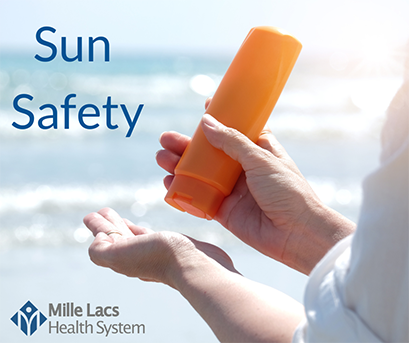Sun Safety
May 29, 2023
May is Sun Protection and Detection Prevention Month. Many people don't realize the potential dangers of prolonged sun exposure, particularly when enjoying water-based activities. This is why wearing sunscreen is essential for keeping your skin safe and healthy while having fun in the sun.
First, it's essential to understand the basics of sun protection. Sunscreen is designed to be applied to skin to protect it from the harmful effects of the sun's ultraviolet (UV) radiation. There are two types of UV radiation that can damage the skin: UVA and UVB. UVA rays are responsible for premature aging, skin cancer, and other long-term effects, while UVB rays cause sunburns and immediate damage.
According to the American Academy of Dermatology, skin cancer is the most common cancer in the United States, affecting one in five Americans during their lifetime. In Minnesota, the incidence rate of melanoma, the deadliest form of skin cancer, has increased by 35% over the past decade. This trend is particularly worrying for lakeside communities, where people spend more time outdoors and are therefore exposed to more direct sunlight. However, the good news is that skin cancer is preventable, and wearing sunscreen is one of the most effective preventative measures.
Recent breakthroughs in sunscreen technology have made it easier and more convenient than ever to protect your skin without compromising the fun. For example, mineral sunscreens, which contain zinc oxide or titanium dioxide, can provide broad-spectrum protection without leaving a white residue on the skin. Additionally, many brands now offer water-resistant formulas that won't wash off in the water or with sweat.
To achieve the best possible protection, it's crucial to understand how much sunscreen to apply and how often to reapply it. The American Academy of Dermatology recommends using at least an ounce of sunscreen (about a shot glass's worth) to cover all exposed areas of your body. You should apply sunscreen 15-30 minutes before going outside and reapply every two hours or immediately after swimming or sweating.
Besides wearing sunscreen, there are other practical steps you can take to reduce your risk of skin damage during summer activities. Wearing a wide-brimmed hat, protective clothing, and seeking shade during peak hours (10 a.m. to 4 p.m.) are all effective ways to minimize sun exposure. Don't forget to protect your eyes by wearing sunglasses that block at least 99% of UVA and UVB rays.
Wearing sunscreen is a simple, yet effective way to reduce your risk of skin cancer, premature aging, and other harmful effects. By following sun safety practices, you can enjoy all the joys of summer while keeping your skin healthy and protected.
